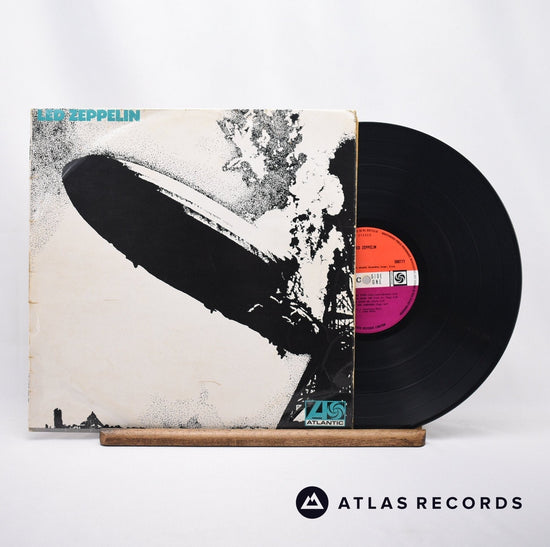A little while ago we came across a pressing of ‘Wheels of Fire’ by Cream that was a little different to other versions of it. From the design of the sleeve, we could tell it was from Taiwan, but that isn’t the end of the tale.
Taiwanese pressings are typically made from regular paper covered in thin, transparent plastic (cellophane) on the inside and out. Many Taiwanese pressings are in fact counterfeit versions that were pressed in the 60s and 70s – they were made cheap to sell on for cheap, hence the poor construction of the sleeves, and the records...


The album we have was pressed by a label called ‘First Record.’ They were the main Taiwanese (bootleg) label of the period, with well over 1000 releases listed on Discogs dating from 1965 until 1985. The music pressed on their records bridges all genres and tastes, from Donna Summer, Steppenwolf to David Bowie, Ringo Starr and Bing Crosby.
This broad variety of records was being sold to a captive audience of the 35,000 US troops who were stationed in Taiwan during the Vietnam war era (1955-1975). They apparently did also sell to locals, but of course it was the US troops who were mostly seeking the latest western releases. It is also likely that these pressings had the same novel appeal for them as they do for us.
These counterfeits were sold in record stores right alongside the authentic (usually EMI Singapore) releases of records, but for a fifth or a quarter of the price. Apparently, a Billboard article from 1970 said that a fake copy would cost $0.70, whilst an authentic copy would set you back $3.50. Those may look like small numbers nowadays, but that difference is just huge!
Did you know?
Of course, the difference in price is justified by the stark difference in pressing and manufacture quality. At the time though, people clearly didn’t care too much, with around 350,000 records being produced every month by 45 factories. And nowadays, people don’t care either – they represent such an interesting time in vinyl history that many collectors are happy to get their hands on a copy, without the need to subject their ears to hearing the pressing quality.
As mentioned previously, the sleeves were made from thin paper covered inside and out with clear cellophane. The paper was often recycled – with the design being printed onto the back (or inside) of another record sleeve or onto something else entirely. If you have one of these, have a look inside the sleeve – maybe there’s something else printed there.


The design of the sleeve would almost always also differ from the original design, whether that be in the colours, text or even spelling. Some collectors have found that their copies even have artist names spelt wrong! It also can’t go unmentioned that despite being an illegal outfit, First Record printed their name, logo and information onto their releases – on the sleeve and the label. This certainly shows some pride and confidence in their work.
The poor quality of the vinyl comes down to the source of the recordings, or the master, if we can call it that. There are two versions of how they produced their copies, with most likely both being legitimate methods they employed. Both methods started out with them acquiring a single copy of the genuine release.


Method one was to create a ‘straight disc dub,’ ie, to physically use that record and electroplating to create a new master stamp which was then used to press the rest of the records. This method is backed up by the fact that many of these Taiwanese pressings have not just their matrix text, but any original matrix information too. For example, etched numbers or stamps like ‘Mastered by Capitol’ which appears on a huge number of US releases.
The secondary method was to tape a recording of this first legitimate copy and to use that tape as the master tape that would be used to lathe cut the master (or mother) disc. We’re getting into ‘How are Records Made’ territory here – you can read our blog post about that if you’d like to learn more.
However they were made, the sound quality can be described as a dull and muted version of the real thing. Not something you’d go out of your way to listen to, but good enough if it’s the only option. The vinyl also varied in colour and transparency – with no two sets of pressings (they were pressed in batches of around 500) being identical.
The sound quality being 'dull and muted' makes perfect physical sense. The copied master stamp will have struggled to get right into the details of the record grooves, meaning the three dimensional cuts are less defined and therefore, the sound is also less defined.
Most of the records are black (or close to it) but one Google search brings up plenty of red and orange hues, as well this particularly impressive transparent green.
Not only were these pressings significantly outselling the legitimate pressings in Taiwan, but a huge number of their records were also being exported – apparently some 150,000 per month, around a third of the total being produced. They were mostly exported to other places in Southeast Asia, including Thailand and the Philippines as well as Hong Kong where a smuggler was once caught with over 900 records amongst his belongings.
First Record aren’t the most successful pirating label without good reason – they are known for producing the best quality counterfeit pressings of the time. The man behind First Record was Yeh Ching-tai, who went on to open Taiwan’s first ever multi-track recording studio in 1980, called ‘Platinum Studio’. In 1988, he started the company ‘Ritek’ who are now a world leading brand for CD and DVD manufacture.
Interestingly, the beginning of Ching-tai's career saw him open a plastic factory (MingLi) in 1952 producing cigarette cases and milk bottles. This could most certainly be part of why he got into producing vinyl, seeing as it is of course also made from plastic. It could even be why his eventual record sleeves have that peculiar plastic covering, but this is all just us speculating.
Before starting up First Record, Ching-tai also started another label in 1957 called Ming Feng Record Company where he learnt about producing vinyl and recording. One of the biggest successes for Ming Feng was Zi Wei's cover of the 1954 song 'Green Island Serenade' which is notable for being one of the first Taiwanese recordings to achieve widespread success in overseas Chinese communities.
Do you own any Taiwanese records from this period, or do you have any more facts to share about this topic? We would love to hear from you - please get in touch with us or leave a comment below.









1 comment
I have a First Label record of Rod Stewart (Smiler) lp.